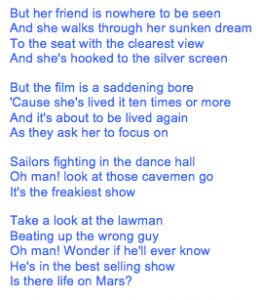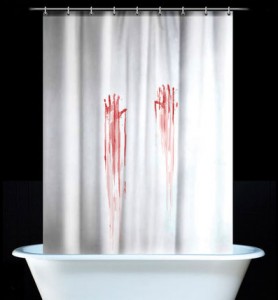A woman with red hair was charging up the stairs towards me. I stepped aside to let her pass, and then, because she wasn’t wearing a mask, I reversed course and followed her. Good choice on my part: She turned out to be Lady Macbeth.
For more than an hour I had been wandering the halls and rooms of the McKittrick Hotel, in Manhattan’s Chelsea district, turning pages in a desktop ledger, pulling books off a bedroom shelf, fishing candy from the glass jars behind a pharmacy counter, losing myself in a maze of Birnam wood. I later learned from the family members and friend who also attended the event that evening that I had missed the rave/orgy. (Twice.) By the time I caught up with Lady Macbeth, I was wondering if I would ever be able to make a narrative out of what I was experiencing. I had also begun to wonder why I would want to.
The performance piece is called Sleep No More, a (very) loose adaptation of Macbeth, by the British theater company Punchdrunk. It takes place over several floors of three former warehouses. We in the audience are free to roam the site, exploring rooms on our own, choosing to follow the actors who happen to cross our paths, or not. We wear white masks in order to distinguish us from the actors who sweep past us in hallways, on staircases, and across spaces of differing dimensions, some as intimate as a drawing room, some as vast as the graveyard or abandoned garden they’re impersonating. But the masks also provoke an uncomfortable association: Are the characters the ghosts here, or are we?
But there I go again, trying to make meaning.
Some of that impulse comes from knowing that a narrative does indeed exist, so why not find it? “McKittrick Hotel” is a reference to a location in Alfred Hitchcock’s Vertigo; music from that movie’s soundtrack plays in several of the rooms: one ghost-drenched drama talking to another. Or the bedroom that I spent at least ten minutes exploring early in my visit: The shelves are filled with old children’s books; a child’s outfit hangs from a bedpost; a doll rests on a pillow. Not until you notice the mirror that turns out not to be a mirror but a window into a parallel room, one that’s identical to this room except it’s been visited by violence—bedsheets strewn, papers littering the floor—might you think, “Oh, right: Macduff’s son.”
But some of the compulsion to find a narrative is innate, perhaps instinctual. It’s not quite the same as patternicity, the term that professional skeptic Michael Shermer coined to describe the effort to discern a pattern that’s not really there. (The classic literature on that fallacy is a paper by David J. Leinweber that “showed the strong statistical association between the annual changes in the S&P 500 stock index and butter production in Bangladesh.”) Shermer has argued “that our brains are belief engines: evolved pattern-recognition machines that connect the dots and create meaning out of the patterns that we think we see in nature. Sometimes A really is connected to B; sometimes it is not.”
But the meaning we try to create out of patterns that we think we see in nature is different from the meaning that we try to create out of narratives that we think we see all around us. Narratives are not just patterns; they’re patterns in progress. They take place over time. As the only species (as far as we know) that possesses self-consciousness, we see ourselves in relation to past and future, as characters in a narrative-in-motion—as actors in a play. And within those narratives, sometimes B really does follow A. And sometimes it does not.
 Just a few minutes ago, I came across this sentence in an article by Shermer: “UFOlogists see a face on Mars.” At the same time, the radio station in the background started playing David Bowie’s “Life on Mars?” If I tried to causally connect the two events, that would be patternicity. Then I found myself wondering, not for the first time, what the song is saying. That’s ploticity. (My efforts to discern that meaning might or might not be futile. Wikipedia says BBC Radio 2 called the song “a cross between a Broadway musical and a Salvador Dalí painting.”)
Just a few minutes ago, I came across this sentence in an article by Shermer: “UFOlogists see a face on Mars.” At the same time, the radio station in the background started playing David Bowie’s “Life on Mars?” If I tried to causally connect the two events, that would be patternicity. Then I found myself wondering, not for the first time, what the song is saying. That’s ploticity. (My efforts to discern that meaning might or might not be futile. Wikipedia says BBC Radio 2 called the song “a cross between a Broadway musical and a Salvador Dalí painting.”)
In the end, Sleep No More rewarded my craving for narrative. As several dozen spectators wearing masks crowded around her, Lady Macbeth entered her spacious chambers, then disrobed, then robed, then persuaded her husband to go forth and commit murder, then bathed him on his return, then went mad. This all happened wordlessly; the entire production is acted through strenuously athletic dancing. But I knew the story well enough that my mind connected the dots: She’s got blood on her hands.
And if I hadn’t known the story well enough? Could I have achieved a state of true narrativelessness? Could I have inhabited a world, even for an hour or two on an otherwise unremarkable Tuesday evening, in which I didn’t at least try to conjure a way that B follows from A? Who can say for certain that if Macbeth didn’t have a plot, it wouldn’t be a tragedy?
* * *
Top image: http://dornob.com/bloody-print-shower-curtains-and-bath-mats/#axzz2YHV76Ycb

